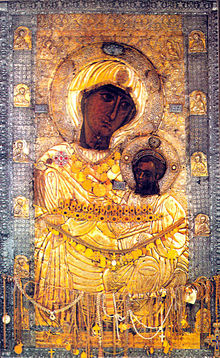
The Panagia Portaitissa (Greek: Παναγία Πορταΐτισσα; Georgian: ივერიის ღვთისმშობლის ხატი) also known as the Iviron Theotokos or Iverskaya in Russian,[1] is an Eastern Orthodox icon of the Virgin Mary in the Georgian Iviron monastery on Mount Athos in Greece, where it is believed to have been since the year 999.[2] According to the sacred tradition of the Eastern Orthodox Church it was painted by Luke the Evangelist.[3] The icon is referred to as "Wonderworking" meaning that numerous miracles have been attributed to the intercession of the Theotokos (Mother of God) by persons praying before it. The synaxis (feast day) for this icon is on February 12,[4] as well as on Bright Tuesday,[2] and also on October 13 for the translation to Moscow of the Iveron icon.[5]

The icon belongs to a family of images of the Theotokos known as Hodegetria (Greek: Όδηγήτρια, "she who leads the way") after the prototype from Constantinople. In these icons, the Christ Child sits on his mother's left arm and she is depicted pointing to Christ with her right hand. Another famous icon based upon Hodegetria is Our Lady of Częstochowa.
A unique characteristic of this icon is what appears to be a scar on the Virgin Mary's right cheek or her chin. A number of different traditions exist to explain this, but the one most commonly held by Orthodox Christians is that the icon was stabbed by a soldier in Nicaea during the period of Byzantine iconoclasm under the Emperor Theophilus (829–842). According to tradition, when the icon was stabbed, blood miraculously flowed out of the wound.
The original in Iveron is encased in a chased riza of silver and gold covering almost all the figures except the faces, as is common with the most venerated icons.
- ^ Also "Iverian Theotokos", "Our Lady of Iveron", or more formally "Wonderworking Icon of the Most Holy Theotokos of Iveron".
- ^ a b Great Synaxaristes (in Greek): Σύναξις Ὑπεραγίας Θεοτόκου τῆς Ἰβηριτίσσης. 12 Φεβρουαρίου. ΜΕΓΑΣ ΣΥΝΑΞΑΡΙΣΤΗΣ.
- ^ Yaroslavtseva, Maria (2007), "Иверская", Православие и Мир (in Russian), retrieved 2007-12-28 English version of Website: www.pravmir.com
- ^ Icon of the Mother of God "Iveron". February 12. OCA - Feasts and Saints.
- ^ October 13/26 Archived 2013-04-17 at archive.today. Orthodox Calendar (Pravoslavie.ru). Retrieved: 2013-02-05.